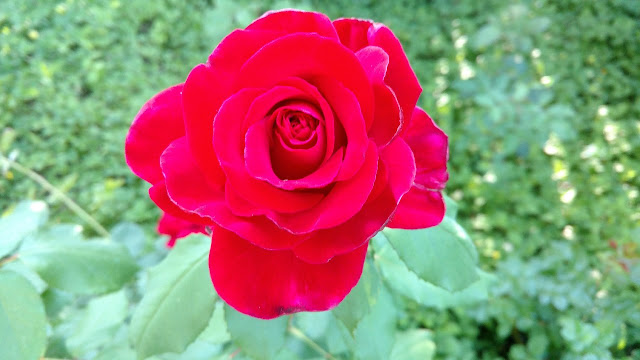
Look at the roots — if you can

|
| This beauty is an Olympiad rose. (Photo: Debbie Arrington) |
Bare-root season is when rose lovers go shopping. Now appearing in local nurseries (or coming soon) are bare-root rose bushes, ready for planting.
“Bare-root” means just what it says; the roots are bare and free from soil. Since roots will determine the strength of future growth, it’s an opportunity to check them out – as well as the above-ground portions of the plant.
These mature rose bushes, at least 2 years old and often older, were “harvested” in October or early November. That’s when they were dug out of fields, often here in California’s Central Valley. (Arizona and Texas also are major rose bush producers.) After harvest, the bushes were placed in cold (not freezing) storage with their roots loosely packed in sawdust or straw. That helps the roots retain their moisture.
Displayed in nurseries, the bare-root bushes often are still standing in sawdust. When browsing, choose a bush with at least three strong canes. Then, pull it out of the sawdust and look at the roots. Ideally, there should be at least three strong roots to match the canes above ground.
What if you can’t see the roots? That’s the case with plastic-wrapped bare-root roses, sold at nurseries as well as home improvement centers and supermarkets. That’s when you have to rely on grades.
Field-grown grafted rose bushes are graded on a scale established by the American Association of Nurseryman. “Grade 1” roses are considered the best.
Under these rules, the Grade 1 standard for hybrid teas includes at least three strong canes (with two at least 18 inches long), well spaced around the graft – where the rootstock connects to the budwood. Grade 1-1/2 roses have two strong canes. Grade 2 roses are overall smaller in size with at least two canes, 12 inches long.
Wrapped or unwrapped, what you do with that rose when you first get it home is the same: Re-hydrate it. That bush is thirsty.
Before planting your new rose bush, soak the roots in a bucket of water overnight. If weather conditions or your garden soil are too wet to plant, the bare-root bush can stay in water for several days.
For more on roses including new varieties, check out the American Rose Society website at https://www.rose.org/ .
Comments
0 comments have been posted.Sacramento Digs Gardening to your inbox.
Food in My Back Yard Series
May 6: Maintain soil moisture with mulch for garden success
April 29: What's (already) wrong with my tomato plants?
April 22: Should you stock up on fertilizer? (Yes!)
April 15: Grow culinary herbs in containers
April 8: When to plant summer vegetables
April 1: Don't be fooled by these garden myths
March 25: Fertilizer tips: How to 'feed' your vegetables for healthy growth
March 18: Time to give vegetable seedlings some more space
March 11: Ways to win the fight against weeds
March 4: Potatoes from the garden
Feb. 25: Plant a fruit tree now -- for later
Feb. 18: How to squeeze more food into less space
Feb. 11: When to plant? Consider staggering your transplants
Feb. 4: Starting in seed starting
Sites We Like
Garden Checklist for week of May 4
Enjoy this spring weather – and get gardening!
* Plant, plant, plant! It’s prime planting season in the Sacramento area. Time to set out those tomato transplants along with peppers and eggplants. Pinch off any flowers on new transplants to make them concentrate on establishing roots instead of setting premature fruit.
* Direct-seed melons, cucumbers, summer squash, corn, radishes, pumpkins and annual herbs such as basil.
* Harvest cabbage, lettuce, peas and green onions.
* In the flower garden, direct-seed sunflowers, cosmos, salvia, zinnias, marigolds, celosia and asters. (You also can transplant seedlings for many of the same flowers.)
* Plant dahlia tubers. Other perennials to set out include verbena, coreopsis, coneflower and astilbe.
* Transplant petunias, marigolds and perennial flowers such as astilbe, columbine, coneflowers, coreopsis, dahlias, rudbeckia and verbena.
* Keep an eye out for slugs, snails, earwigs and aphids that want to dine on tender new growth.
* Feed summer bloomers with a balanced fertilizer.
* For continued bloom, cut off spent flowers on roses as well as other flowering plants.
* Add mulch to the garden to maintain moisture. Mulch also cuts down on weeds. But don’t let it mound around the stems or trunks of trees or shrubs. Leave about a 6-inch to 1-foot circle to avoid crown rot or other problems.